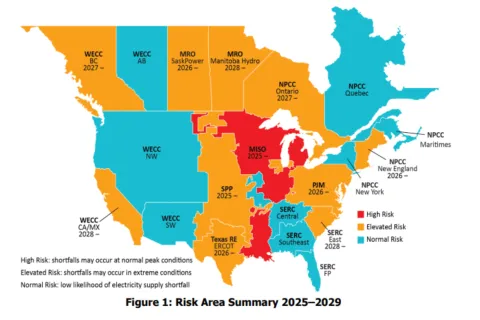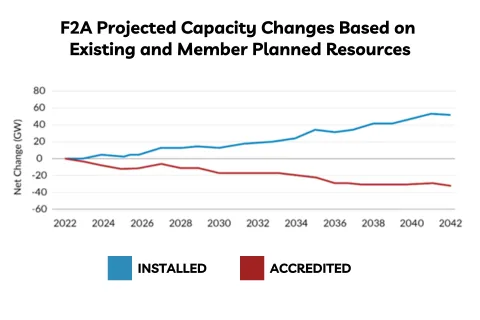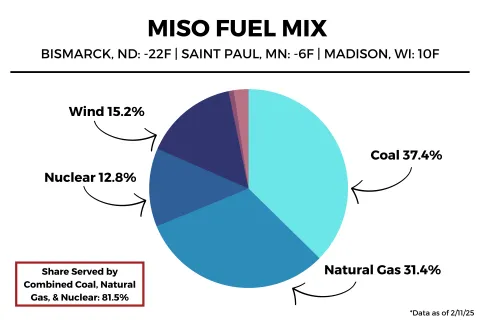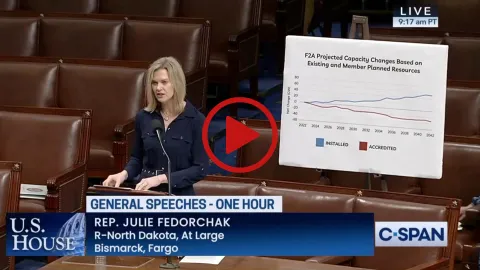On the House Floor: Fedorchak offers solutions for energy reliability crisis
Washington, D.C. — Congresswoman Julie Fedorchak (R-ND) hosted a Special Order on the House Floor yesterday to sound the alarm on the increasing threats to America’s energy reliability. She highlighted how two-thirds of our country is at risk of not having enough reliable power to meet demand and offered five solutions to restore grid reliability.
Below are her remarks as prepared for delivery:
Thank you, Mr. Speaker.
I wanted to start this speech with a real-time exercise. I wanted to suddenly have all the lights go out in here.
Imagine what would happen if we did that. It would be pitch black in this room.
Everything would come to a halt. The microphones would stop. We wouldn’t be able to see each other. People watching online would certainly be confused. We would all wonder what was going on.
Would we be able to see to walk around? To get out? Would anyone panic?
Then, let’s imagine if the outage wasn’t just in this room or this building but all across Washington, D.C.
At first there would be silence. But it wouldn’t take long before confusion and perhaps chaos ensued.
Now, let’s imagine this happening in my state of North Dakota, where just this week, temperatures dropped to –22 degrees for many days in a row.
In fact, this morning was the first day it rose above zero.
What would that mean to lose power when it’s 22 below.
People’s livelihoods would be at risk.
Children couldn’t go to school.
Hospitals would be unable to care for people.
Businesses would come to a standstill.
Energy production would halt.
Livestock would be threatened.
Homes and properties would freeze up.
It wouldn’t take very long in that kind of weather for the economy of North Dakota to grind to a halt and for people to die if we had no power.
This isn’t some far-fetched scenario. This is a real threat in America today.

The North American Electric Reliability Corporation (NERC) warns that two-thirds of the United States is at an elevated risk of blackouts—of not having enough reliable power to meet demand when we need it the most.
This map clearly illustrates the problem. This is a scenario today in America.
And that’s why I am on the House Floor today—to sound the alarm about our grid reliability crisis, and to highlight five practical solutions to keep the lights on.
GRID RELIABILITY CRISIS
But first, let’s talk about why this is happening. What’s driving this problem?
It really comes down to one thing: We are retiring power plants faster than we’re replacing them.
Seriously, it’s that simple.
In states throughout our nation, power providers are shutting down massive amounts of traditional power generation from power plants that can be turned up or down as needed to follow demand.
And they're retiring these generators faster than they’re able to bring on new generators that can provide the same kind of always-available power.
Grid operators measure this availability in terms of capacity. And there are two kinds.

First, there’s “installed capacity.” That’s the maximum amount of power a generator can churn out in the best conditions.
For example, most windfarms in North Dakota have a nameplate capacity of 300 megawatts. Our largest coal-fired facility is 1100 megawatts.
The second “capacity” term is called “accredited capacity.” That’s the amount of power that can be counted on regardless of conditions.
Grid operators determine the value of accredited capacity.
They look at the performance of a generator over time, how it works under different conditions, and they determine how much of that power they can rely on when they need it the most in any weather condition.
That same windfarm would likely have an accredited capacity that is 30 percent of its nameplate capacity, or in a 300-megawatt windfarm, a fraction of that would be accredited capacity.
The coal facility probably comes in at about 80-90 percent of nameplate capacity, so about 950 megawatts of accredited capacity.
In the MISO market, this region here, in red, that serves 15 states, roughly 42 million Americans get their power in the MISO region.
The operators in that region warn that accredited capacity is shrinking dramatically, even though we’re spending a lot of money installing more and more generation on a nameplate capacity.
If you ever wonder why your utility prices are rising, but you face more risks for blackouts or brownouts, this gap is why!
That’s why NERC keeps warning us with reports, forecasts, and maps like this. MISO is in the red zone on this map. All the yellow zones also have elevated risk.
In a nation as blessed with natural resources and brilliant people like the United States, there is no reason to ever run short of power.
Our whole country should be blue. We should never run out of power. Ever.
We will have storms that knock the power off for a time, but to not have enough power to meet demand? That’s just bad planning and terrible leadership.
But that’s the bad news today.
The good news is this: We can fix this. We have the resources. We have the technology. AND now we just need to act.
And here are five key steps—the five solutions to this problem.
REGULATORY RELIEF
First, we need regulatory relief.
Right now, federal regulations are strangling our energy producers, making it nearly impossible for them to meet our power demand.
We must repeal the EPA’s greenhouse gas rule, we must eliminate the methane fee rule, and roll back the BLM resource management plan for North Dakota and other states.
And we must reform the new source performance standards that prevent power providers from making efficiency improvements to their existing fleet—the ones that are already connected to the grid—to improve them, to help them produce more power in a cleaner, more efficient way.
That new source performance standards is just bad policy. It makes no sense at all.
These are just a few examples of Biden administration policies that have imposed crushing costs and regulatory burdens on the power sector. They’re jeopardizing the stability of our grid and the livelihoods of hardworking Americans.
REEVALUATING FEDERAL INCENTIVES
Second, we must reevaluate federal incentives for energy production.
Our government has distorted the energy market with subsidies that favor certain resources while neglecting others.
This has resulted in a grid that is too dependent on the weather. Think back to the map from NERC. Two-thirds of the country at an elevated risk of not having enough power to meet demand.
It’s time to realign these incentives.
Today, our grid operators are calling for more dispatchable generation, more capacity. They want to fill that gap in those two lines I showed earlier.
Think of the MISO Zone in red on my first map.
MISO is desperate for more power resources that can be turned on when needed. But here is the stack of resources that are in line to connect with the MISO grid.

We must ensure that federal policy doesn’t exacerbate this problem and the current vulnerabilities created by a flood of win and solar, which are weather-dependent generation.
Instead, we must support fair markets that better encourage the investments needed to meet growing demand and long-term grid reliability and stability.
PERMITTING REFORM
Third, we need to speed up the permitting process.
Right now, it can take years—sometimes decades—to get approval for new energy projects.
This is unacceptable, especially when we have transformative technologies ready to go, like Small Modular Reactors.
These advanced nuclear systems are safe, reliable, clean, and capable of powering entire communities.
I look forward to working with my colleagues in the House and leaders like Energy Secretary Chris Wright to cut through the bureaucratic red tape and accelerate deployment of these new technologies.
RULES THAT PROTECT RELIABILITY
Fourth, we must implement rules that protect grid reliability.
As I mentioned earlier, it was well below freezing throughout North Dakota this week.
My state and region weathered those temperatures largely because of coal, natural gas, and nuclear power.
Straight from the MISO data, here’s the energy mix that served that region this week.

Yet despite this reality, states are racing to shut down these reliable, base load power generators that are responsible for powering our communities, replacing it with intermittent sources that cannot reliably meet all the demands of our grid or the people who depend on it.
I have nothing against wind and solar. North Dakota has tons of wind generation online.
But it’s simply not capable today to meet the demands of the grid. And the people who are responsible for making sure our grid is reliable are the ones saying that—over and over.
This is reckless.
We need federal safeguards to ensure that before a power plant is retired, there’s a reliable replacement ready to go online.
We cannot afford to gamble with our nation’s energy security. Energy security is national security.
MEETING THE DEMANDS OF AI
And finally, we need to better understand the growing demands of the AI industry.
AI and other data-intensive technologies are driving massive increases in energy consumption.
As Vice President Vance acknowledged in Paris this week, if we are to remain competitive in the global economy, we need to remove the barriers to development and unleash the full potential of American energy resources.
This means embracing an all-of-the-above strategy—that includes battery technology to back up renewables, but also, oil, gas, nuclear, and hydropower—whatever it takes to power our future.
Mr. Speaker, grid reliability is not a partisan issue. It’s an American issue.
Our security, our economy, and our way of life depend on it.
We cannot be a beacon for the world—or even safe in our own homes—if we are sitting in the dark without power.
We have the resources. We have the technology. Now, we must act.
America can and must remain the most powerful, prosperous, and innovative nation on earth.
I look forward to working with my colleagues to do just that.
Thank you, and I yield back.
CLICK HERE to watch the full speech.
###
